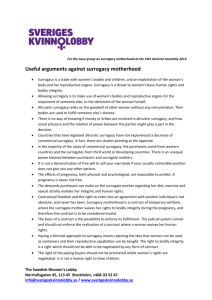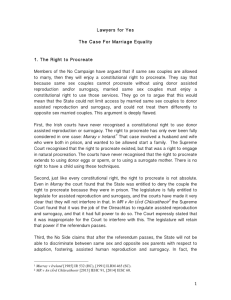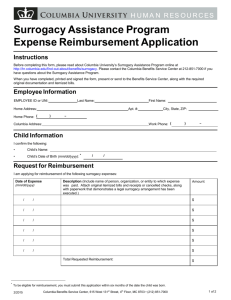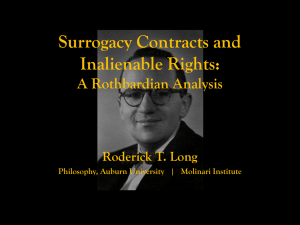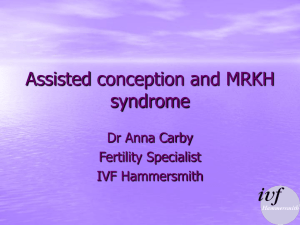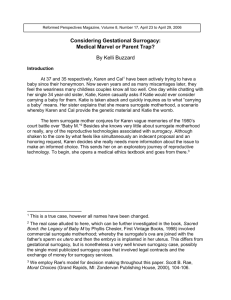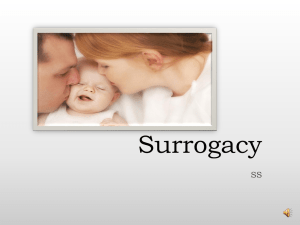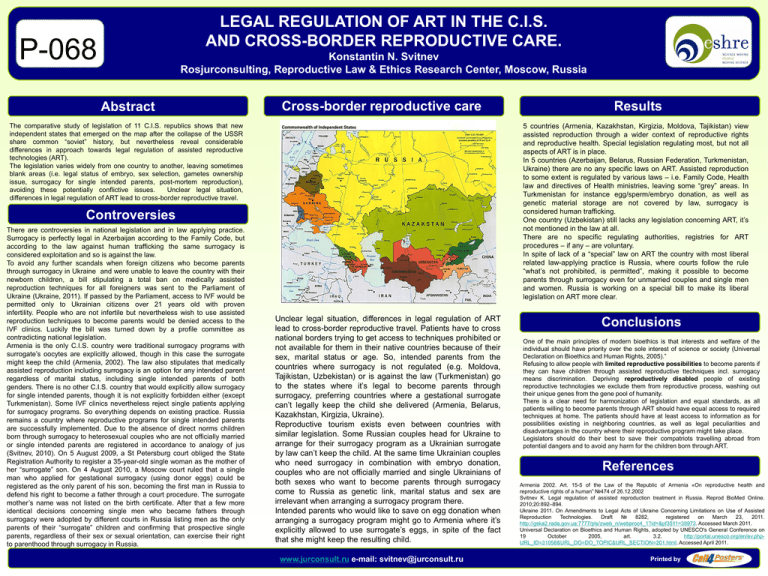
LEGAL REGULATION OF ART IN THE C.I.S.
AND CROSS-BORDER REPRODUCTIVE CARE.
P-068
Konstantin N. Svitnev
Rosjurconsulting, Reproductive Law & Ethics Research Center, Moscow, Russia
Abstract
Cross-border reproductive care
The comparative study of legislation of 11 C.I.S. republics shows that new
independent states that emerged on the map after the collapse of the USSR
share common “soviet” history, but nevertheless reveal considerable
differences in approach towards legal regulation of assisted reproductive
technologies (ART).
The legislation varies widely from one country to another, leaving sometimes
blank areas (i.e. legal status of embryo, sex selection, gametes ownership
issue, surrogacy for single intended parents, post-mortem reproduction),
avoiding these potentially conflictive issues.
Unclear legal situation,
differences in legal regulation of ART lead to cross-border reproductive travel.
5 countries (Armenia, Kazakhstan, Kirgizia, Moldova, Tajikistan) view
assisted reproduction through a wider context of reproductive rights
and reproductive health. Special legislation regulating most, but not all
aspects of ART is in place.
In 5 countries (Azerbaijan, Belarus, Russian Federation, Turkmenistan,
Ukraine) there are no any specific laws on ART. Assisted reproduction
to some extent is regulated by various laws – i.e. Family Code, Health
law and directives of Health ministries, leaving some “grey” areas. In
Turkmenistan for instance egg/sperm/embryo donation, as well as
genetic material storage are not covered by law, surrogacy is
considered human trafficking.
One country (Uzbekistan) still lacks any legislation concerning ART, it’s
not mentioned in the law at all.
There are no specific regulating authorities, registries for ART
procedures – if any – are voluntary.
In spite of lack of a “special” law on ART the country with most liberal
related law-applying practice is Russia, where courts follow the rule
“what’s not prohibited, is permitted”, making it possible to become
parents through surrogacy even for unmarried couples and single men
and women. Russia is working on a special bill to make its liberal
legislation on ART more clear.
Controversies
There are controversies in national legislation and in law applying practice.
Surrogacy is perfectly legal in Azerbaijan according to the Family Code, but
according to the law against human trafficking the same surrogacy is
considered exploitation and so is against the law.
To avoid any further scandals when foreign citizens who become parents
through surrogacy in Ukraine and were unable to leave the country with their
newborn children, a bill stipulating a total ban on medically assisted
reproduction techniques for all foreigners was sent to the Parliament of
Ukraine (Ukraine, 2011). If passed by the Parliament, access to IVF would be
permitted only to Ukrainian citizens over 21 years old with proven
infertility. People who are not infertile but nevertheless wish to use assisted
reproduction techniques to become parents would be denied access to the
IVF clinics. Luckily the bill was turned down by a profile committee as
contradicting national legislation.
Armenia is the only C.I.S. country were traditional surrogacy programs with
surrogate’s oocytes are explicitly allowed, though in this case the surrogate
might keep the child (Armenia, 2002). The law also stipulates that medically
assisted reproduction including surrogacy is an option for any intended parent
regardless of marital status, including single intended parents of both
genders. There is no other C.I.S. country that would explicitly allow surrogacy
for single intended parents, though it is not explicitly forbidden either (except
Turkmenistan). Some IVF clinics nevertheless reject single patients applying
for surrogacy programs. So everything depends on existing practice. Russia
remains a country where reproductive programs for single intended parents
are successfully implemented. Due to the absence of direct norms children
born through surrogacy to heterosexual couples who are not officially married
or single intended parents are registered in accordance to analogy of jus
(Svitnev, 2010). On 5 August 2009, a St Petersburg court obliged the State
Registration Authority to register a 35-year-old single woman as the mother of
her “surrogate” son. On 4 August 2010, a Moscow court ruled that a single
man who applied for gestational surrogacy (using donor eggs) could be
registered as the only parent of his son, becoming the first man in Russia to
defend his right to become a father through a court procedure. The surrogate
mother’s name was not listed on the birth certificate. After that a few more
identical decisions concerning single men who became fathers through
surrogacy were adopted by different courts in Russia listing men as the only
parents of their “surrogate” children and confirming that prospective single
parents, regardless of their sex or sexual orientation, can exercise their right
to parenthood through surrogacy in Russia.
Results
Unclear legal situation, differences in legal regulation of ART
lead to cross-border reproductive travel. Patients have to cross
national borders trying to get access to techniques prohibited or
not available for them in their native countries because of their
sex, marital status or age. So, intended parents from the
countries where surrogacy is not regulated (e.g. Moldova,
Tajikistan, Uzbekistan) or is against the law (Turkmenistan) go
to the states where it’s legal to become parents through
surrogacy, preferring countries where a gestational surrogate
can’t legally keep the child she delivered (Armenia, Belarus,
Kazakhstan, Kirgizia, Ukraine).
Reproductive tourism exists even between countries with
similar legislation. Some Russian couples head for Ukraine to
arrange for their surrogacy program as a Ukrainian surrogate
by law can’t keep the child. At the same time Ukrainian couples
who need surrogacy in combination with embryo donation,
couples who are not officially married and single Ukrainians of
both sexes who want to become parents through surrogacy
come to Russia as genetic link, marital status and sex are
irrelevant when arranging a surrogacy program there.
Intended parents who would like to save on egg donation when
arranging a surrogacy program might go to Armenia where it’s
explicitly allowed to use surrogate’s eggs, in spite of the fact
that she might keep the resulting child.
www.jurconsult.ru e-mail: svitnev@jurconsult.ru
Conclusions
One of the main principles of modern bioethics is that interests and welfare of the
individual should have priority over the sole interest of science or society (Universal
Declaration on Bioethics and Human Rights, 2005).”
Refusing to allow people with limited reproductive possibilities to become parents if
they can have children through assisted reproductive ttechniques incl. surrogacy
means discrimination. Depriving reproductively disabled people of existing
reproductive technologies we exclude them from reproductive process, washing out
their unique genes from the gene pool of humanity.
There is a clear need for harmonization of legislation and equal standards, as all
patients willing to become parents through ART should have equal access to required
techniques at home. The patients should have at least access to information as for
possibilities existing in neighboring countries, as well as legal peculiarities and
disadvantages in the country where their reproductive program might take place.
Legislators should do their best to save their compatriots travelling abroad from
potential dangers and to avoid any harm for the children born through ART.
References
Armenia 2002. Art. 15-5 of the Law of the Republic of Armenia «On reproductive health and
reproductive rights of a human” №474 of 26.12.2002
Svitnev K. Legal regulation of assisted reproduction treatment in Russia. Reprod BioMed Online.
2010;20:892–894.
Ukraine 2011. On Amendments to Legal Acts of Ukraine Concerning Limitations on Use of Assisted
Reproduction
Technologies.
Draft
№
8282,
registered
on
March
23,
2011.
http://gska2.rada.gov.ua:7777/pls/zweb_n/webproc4_1?id=&pf3511=39973. Accessed March 2011.
Universal Declaration on Bioethics and Human Rights, adopted by UNESCO's General Conference on
19
October
2005,
art.
3.2.
http://portal.unesco.org/en/ev.phpURL_ID=31058&URL_DO=DO_TOPIC&URL_SECTION=201.html. Accessed April 2011.
Printed by


